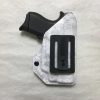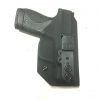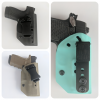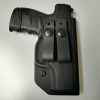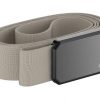Any time you’re at the range shooting and you pull the trigger expecting to fire a shot (a BANG!) and instead you get a *click* you probably have some sort of malfunction. There are different types of malfunctions and they can be caused by a variety of things. Simple things like operator error – such as failure to load a cartridge into the chamber or using poor grip technique (“limp-wristing”) can cause you to get a click and not a bang. Although it is very rare with modern factory ammunition, you could have faulty old/wet primer/powder or a casing could be slightly out of tolerance. Still another possibility is an equipment issue such as a broken extractor, weak magazine spring, or just dirt and grime fouling up the normal function of the handgun.
magazine spring, or just dirt and grime fouling up the normal function of the handgun.
Every once in a while, random things might happen like a casing gets stuck in the ejection port as the slide is returning to battery (pictured…aka “stove-pipe”).
To keep things simple, there are three major types of semi-auto handgun malfunctions –misfires, hangfires, and squib loads:
Misfires: The majority of issues fall into this category. There are four different types of misfires and they are categorized as Failure-To-Fire, Failure-To-Feed (FTF), Failure-To-Eject (FTE) which is usually referred to as a “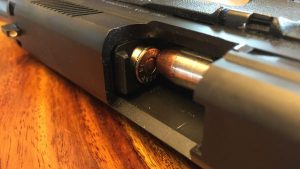 stovepipe” or “smokestack”, and Failure-To-Extract. The last one usually induces what’s known as a “double-feed” (pictured), where a second cartridge is trying to load on top of one which did not get extracted from the chamber.
stovepipe” or “smokestack”, and Failure-To-Extract. The last one usually induces what’s known as a “double-feed” (pictured), where a second cartridge is trying to load on top of one which did not get extracted from the chamber.
Hangfires: A hangfire is when you get a click, a delay, and then a bang. This is caused by faulty ammunition – usually a problem with the primer or powder. Hangfires are very rare with modern factory ammunition, but can be dangerous if you do not keep the gun pointed in a safe direction.
Squib Loads: A squib load is one that results in a softened “pop” or “puff” instead of a normal “bang” when the trigger is pulled. The cartridge may or may not have had created enough energy to propel the bullet all the way out of the barrel. While this is even more rare than a hangfire, it can be very dangerous if you attempt to fire another round and the barrel is plugged with the previous bullet. The resulting explosion could cause serious injury. If you ever think you may have had a squib load, play it safe and do not fire another round. Remove the magazine, lock the slide open and get help if you are unsure of how to proceed.
How to Minimize Malfunctions
Use proper technique – Using a hard crush grip and keeping your wrists and arms firm while shooting will enable the action of the gun to work properly. Using proper loading procedure – don’t baby or ride the slide – will make sure a round is loaded into the chamber correctly.
Use quality factory ammunition – Modern factories have great quality control and using good range ammunition will minimize the chance of any faulty ammunition issues. Resist the urge to go super-cheap or 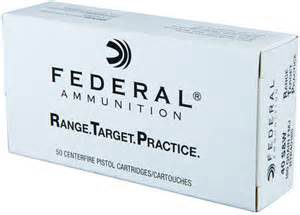 borrow some hand-loaded/reloaded rounds from your neighbor until you are confident enough to verify he/she really knows what they are doing and can consistently produce good results.
borrow some hand-loaded/reloaded rounds from your neighbor until you are confident enough to verify he/she really knows what they are doing and can consistently produce good results.
Clean your firearm regularly and properly – Dirt and grime will eventually cause problems in even the most sturdy and reliable of handguns. Make it a habit to clean your guns often (especially those used for personal defense!) and check the function after each cleaning. Use the proper tools and follow instructions in the owner’s manual or search online to make sure you are doing it right.
If you are unsure about any of this, please give us a call or find another shooter who can help you out.
What do I do when I have a malfunction?
When you are practicing at a public shooting range, the safety of everyone is the top priority and care should be taken to remove any possible element of danger to yourself and those around you. To the contrary, if you are ever unfortunate enough to be in a gunfight for your life, your priorities will be (and should be!) different. In this article, we have outlined a procedure for our students to safely remedy a malfunction at the practice range. This procedure provides a foundation for more advanced skill development, such as performing a quick Tap-Rack-Assess clearance in an emergency situation.
For any malfunction:
- Take your finger off the trigger – As a matter of habitual safety, we keep our finger off the trigger any time we are not aimed on target and ready to fire and this includes any time we are manipulating the firearm for any purpose, such as a malfunction clearance or reload. Specific to malfunctions, we want to make sure another shot is not taken on top of a potential squib load.
- Keep the firearm pointed in a safe direction – downrange. Again, as a matter of creating good firearm safety habits, we ALWAYS keep the firearm pointed in a safe direction, especially important if there is a hangfire malfunction.
- Wait 30 seconds – It takes about 30 seconds to say your ABCs in your head twice. We’ve heard different lengths of time for this precaution, but feel 30 seconds is appropriate to make sure there isn’t a hangfire and have a brief moment to collect your thoughts and take a few breaths.
- Perform a Tap-Rack-Assess – Tap (smack) the bottom of the magazine to make sure it is fully seated, rack the slide hard once, and assess your situation. Most of the time, this procedure will get you back to shooting.
- If the Tap-Rack-Assess doesn’t work, meaning your slide is stuck or you still get a click, it is time to clear the chamber and reload. Chances are, you probably have a double-feed. In this situation we perform a Lock-Drop-Rack-Reload. First, lock the slide open to remove the pressure of loading cartridges off the ones in the chamber. Next, remove the magazine – you may have to grab the magazine at the base and rip it out if it is stuck. At this point, be aware that there may be a live round in the chamber so ALWAYS keep the muzzle pointed downrange and your finger off trigger. Rack the slide three times to clear the chamber and any other casings that may have been lodged. Finally, reload a new magazine and assess your situation.
- If you need assistance, lock the slide open if possible and set the gun down on the bench with the muzzle pointed downrange. Raise your hand or go get a Range Officer. Ask another shooter to help if the RO is not available.
**This article has addressed issues common to semi-auto pistols. Of course, revolvers are a bit more simple in operation and have less chance for action related malfunctions. Usually, if you have an ammunition issue, just press the trigger again or reload. However, there are some possible issues revolver shooters should learn how to deal with at the range – or know when to call the gunsmith. Until we get around to Part 2, please read here for more information on revolver malfunctions.




